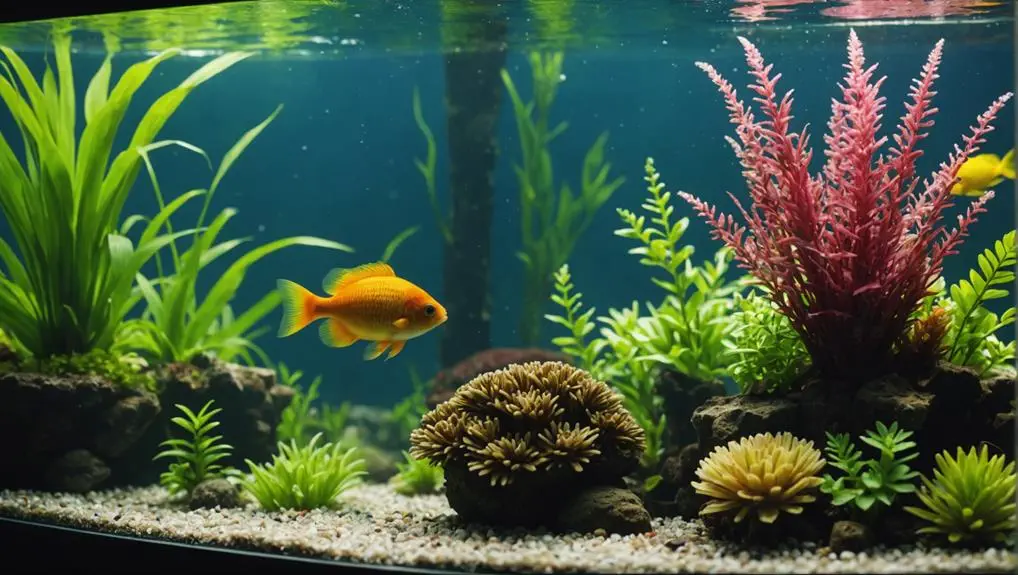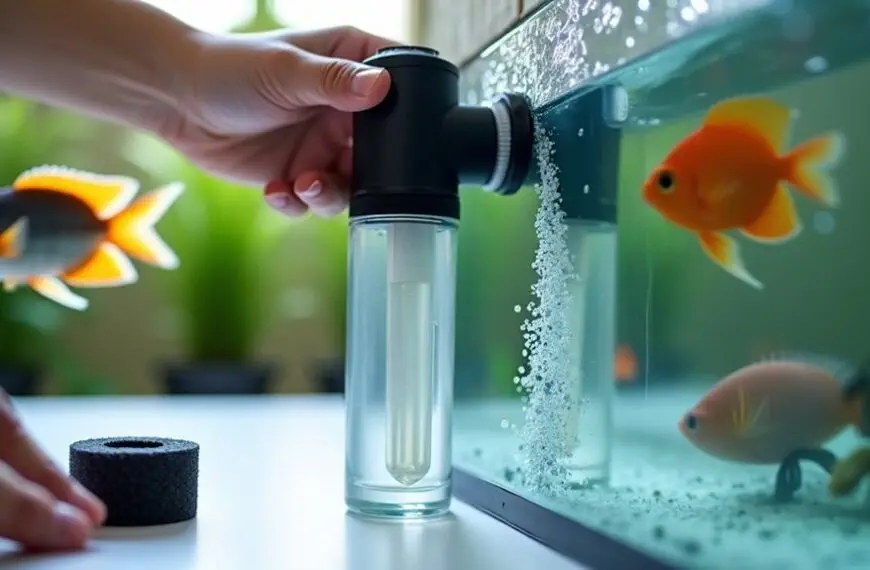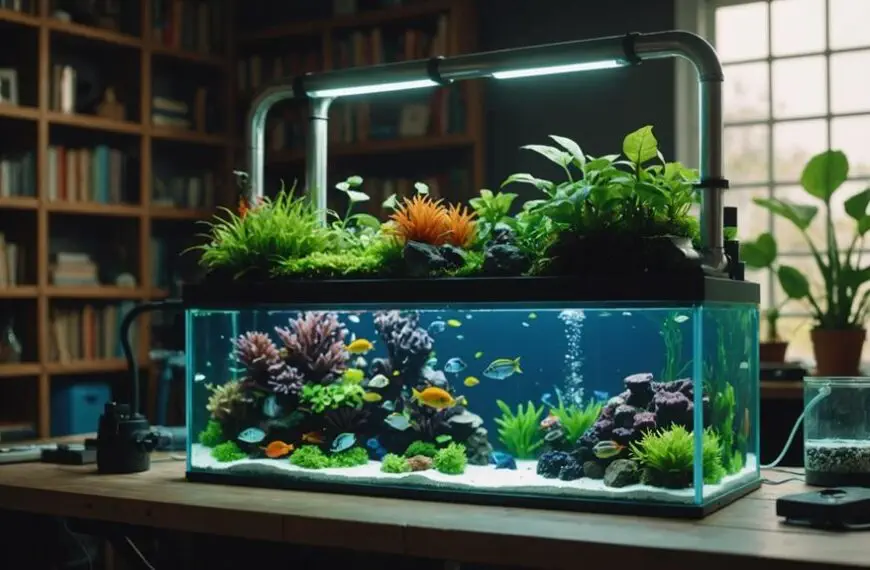When troubleshooting common fish tank filtration issues, start by checking for poor water flow, leaks, or noise. If your filter's acting like a grumpy cat, make sure to clean any clogs and inspect seals for damage. No one likes a noisy filter, so tighten loose parts and adjust the water level to avoid air intake issues. For leaks, a quick check of seals and housing can save the day. Remember, regular maintenance is key to fish happiness. Keep an eye on water quality too, and you might just become the ultimate fish whisperer! Curious about optimizing your setup?
Contents
- 1 Importance of Proper Filtration
- 2 Identifying Common Filtration Problems
- 3 Insufficient Water Flow Solutions
- 4 Addressing Excessive Noise Issues
- 5 Fixing Leaking Filter Problems
- 6 Routine Maintenance Practices
- 7 Types of Filtration Systems
- 8 Upgrading Your Filtration System
- 9 Testing Water Quality Regularly
- 10 Seeking Expert Advice
- 11 Frequently Asked Questions
- 12 Final Thoughts
Importance of Proper Filtration
When it comes to maintaining a healthy aquarium, proper filtration is crucial. You wouldn't want your fish swimming in a toxic soup, right? A good filtration system removes harmful waste products and keeps the water quality high. It's like giving your fish a nice spa day!
Regular water quality checks can prevent toxic buildup from occurring, ensuring that your filtration system is working effectively to avoid fish stress.
Not only does effective filtration help eliminate toxins, but it also supports beneficial bacteria. These little helpers break down nasty substances like ammonia and nitrite, which can spike in poorly filtered tanks. You want those bacteria working hard for your aquatic pals!
Plus, a well-maintained filtration system ensures adequate water circulation, which is essential for aeration. Your fish need oxygen just as much as we do, after all.
Regular maintenance is key. If you let things slide, poor water quality can stress out your fish and increase their chances of getting sick. Trust me, nobody wants that.
Make sure to choose the right filtration type and size for your tank's volume and the fish species you have. By doing this, you'll create a more stable aquatic ecosystem where your fish can thrive. Happy fish, happy you!
Identifying Common Filtration Problems
Sometimes, your fish tank's filter just doesn't seem to be doing its job, and that's when you might notice insufficient water flow or hear some unexpected noises.
If your filter's leaking, it could be time for a closer look since it might be sending more water out of the tank than it should!
Don't worry; identifying these common filtration problems can help keep your aquatic friends happy and healthy.
Insufficient Water Flow
Insufficient water flow in your fish tank can lead to serious problems, affecting both water quality and fish health. When the filter media gets clogged, it restricts the flow, so cleaning or replacing it according to the manufacturer's instructions can work wonders.
Don't forget to check the intake strainer, too! Debris can build up, diminishing water flow. A quick inspection and a gentle brush or rinse can keep things flowing smoothly.
Another critical component is the impeller. If it's blocked or showing signs of wear, you may need to replace it to restore that essential water flow. It's like giving your fish a refreshing swim!
Also, consider adjusting how much and how often you feed your fish. Uneaten food can pile up and clog your filtration system, leading to insufficient water flow.
Regular maintenance is key in this process. It ensures optimal filter performance and keeps your fish happy and healthy.
Excessive Noise Issues
If your filtration system is running smoothly but you're still hearing unwanted noises, it's time to investigate further. Excessive noise from your aquarium filters can be a real headache.
Start by checking for loose or improperly tightened components; securing these can significantly reduce those annoying vibration sounds.
Next, consider air intake issues. If your filter isn't primed correctly or the water levels are too low, you might hear gurgling or hissing noises. This usually means air is trapped in your system, and it's time for a little adjustment.
Don't forget to check the impeller. If it's worn or damaged, you may hear grinding or rattling sounds. A quick inspection could save you from a noisy disaster.
Lastly, make sure your filter setup is stable. Unusual vibrations often come from an unstable installation. A solid, level position can work wonders in quieting things down.
If you've tried everything and the noise persists, consider repositioning the filter or adding some noise-absorbing materials. Your fish (and your ears) will thank you!
Leaking Filter Problems
Leaking filters can be a frustrating problem for any aquarium owner, but identifying the source of the issue is the first step toward resolution.
Often, leaking filters happen due to damaged components like seals or O-rings. If you notice water pooling around your filter, it might be time to replace these worn parts.
Another culprit could be cracks in the filter housing. Take a close look for any physical imperfections; a small crack can lead to big water problems.
It's also crucial that you ensure proper installation. Reviewing the installation instructions can help you catch any mistakes, as secure connections are key to avoiding leaks.
Don't forget to keep your filter level during installation. An unlevel filter can cause water spillage, making things messier than they need to be.
Regularly monitoring for signs of leakage, like puddles around the filter base, will help you nip issues in the bud.
Insufficient Water Flow Solutions

If you're noticing sluggish water flow in your tank, don't worry—you're not alone!
Start by giving that intake strainer a good cleaning to clear out any pesky debris that might be blocking the flow.
Additionally, ensure your filtration system is appropriate for your tank size, as a good filtration system is essential for maintaining a healthy aquatic environment.
Also, take a moment to check your filter media and impeller; keeping these in top shape can make a world of difference in your fish's underwater paradise!
Clean Intake Strainer Regularly
A clean intake strainer is crucial for maintaining optimal water flow in your fish tank. When you neglect this little piece of equipment, even small blockages can lead to big problems.
Regular maintenance of the intake strainer ensures that your filter operates efficiently, keeping your aquatic friends happy and healthy. Here are some key tips to keep in mind:
- Inspect the intake strainer every few weeks for debris.
- Use a soft brush to gently clean it, removing algae and gunk.
- Rinse the strainer under water to prevent buildup.
- Check the intake tube for any signs of clogs.
- Remember that a clean strainer leads to better water flow and filter efficiency.
Inspect Filter Media Condition
To ensure your fish tank's filtration system works efficiently, regularly inspecting the condition of your filter media is essential. Think of filter media like the lungs of your aquarium; if they're clogged with debris, your fish will struggle to breathe!
Regular checks can help you spot any clogs that might be reducing filtration efficiency. When you notice a decrease in water flow from your filter, it's a sign your filter media might need some attention. Follow the manufacturer's guidelines for cleaning or replacing it.
But remember, over-cleaning can disrupt the beneficial bacteria that keep your water healthy—like removing all the good stuff from your fridge!
To clean your filter media, use a soft brush or rinse it in old tank water instead of tap water, which can be harsh due to chlorine. If you're really looking to boost your filtration game, consider upgrading to higher-performance filter media with greater surface area.
This can improve water flow and enhance biological filtration capacity, keeping your underwater friends happy and thriving. So roll up your sleeves, and let's keep that tank sparkling clean together!
Maintain Impeller Performance
After ensuring your filter media is in good shape, it's time to focus on maintaining the impeller performance.
This little powerhouse plays a crucial role in keeping your water flow steady and your filtration efficiency high.
Here's how to keep it running smoothly:
- Regularly inspect the impeller for blockages or debris.
- Check for signs of wear or damage; don't hesitate to replace it if necessary.
- Ensure the impeller is properly seated in its housing—misalignment can cause all sorts of trouble.
- Use a soft brush or a cleaning solution recommended by the manufacturer to keep it clean.
- Monitor the water flow rate after maintenance; a decrease might signal ongoing issues.
Addressing Excessive Noise Issues
Excessive noise from your fish tank filter can be frustrating and disrupt the peaceful ambiance of your aquarium. Don't worry; there are some simple fixes you can try!
First, check your filter setup. If any components are loose, tighten them up. Loose connections can cause vibrations, leading to that pesky noise. Additionally, maintaining optimal water quality parameters can help reduce stress on your filter system, potentially minimizing noise levels.
Next, take a look at your water level. A low water level can create air intake issues, which might contribute to the racket. Adjust the water level as needed to keep your filter running smoothly.
Also, don't forget to inspect the impeller. If it's worn or damaged, it could be the main culprit behind the noise. Replacing it based on the manufacturer's recommendations can make a world of difference.
Lastly, ensure your filter has a stable installation. Unusual vibrations may signal that it's not properly secured. If noise still persists, consider the surrounding environment. Repositioning the filter or adding sound-absorbing materials can help diminish that unwelcome sound, making your tank a peaceful haven for both you and your aquatic friends.
With these tips, you'll be back to enjoying the soothing sounds of your aquarium in no time!
Fixing Leaking Filter Problems
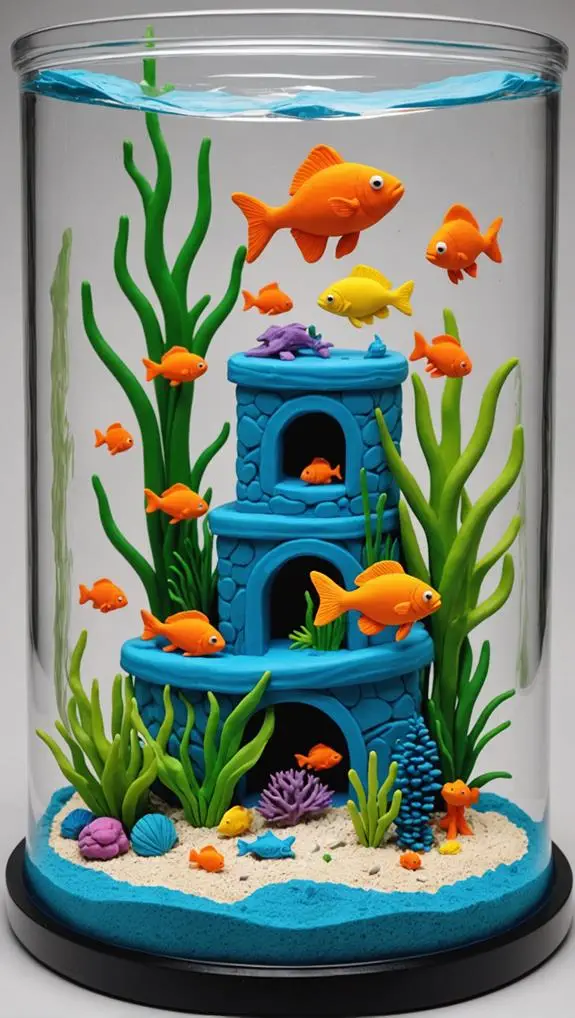
If you notice water pooling around your fish tank filter, don't panic—leaks are a common problem!
Start by checking those seals and O-rings; a little wear and tear can lead to big puddles.
Also, give the filter housing a good look; cracks there might mean it's time for a replacement, so your fish can keep swimming happily!
Inspect Seals and O-Rings
Regularly inspecting seals and O-rings is essential for preventing leaks in your fish tank filtration system. These components are your first line of defense against unwanted water escapes, so it's vital to check them often.
A small leak can lead to big problems, and nobody wants a soggy floor!
Here are some tips for your inspection routine:
- Look for signs of wear: Cracks or fraying can indicate it's time for a change.
- Ensure proper alignment: Misaligned O-rings can easily cause leaks, so double-check their placement.
- Check for deterioration: Constant water exposure can wear down seals over time, so replace them as needed.
- Use silicone grease: Applying this special grease to your O-rings helps keep them flexible and creates a better seal.
- Be mindful of filter housing: Regularly examine it for cracks, as even tiny damage can impact filtration performance.
Check Filter Housing Condition
How often do you take a close look at your filter housing? It's easy to forget, but inspecting it regularly can save you a big headache down the road!
Start by checking for any visible cracks or damage that could lead to leaks. Even tiny imperfections can put your tank at risk. Next, make sure all seals and O-rings fit snugly and aren't worn out. Misaligned or deteriorated seals are notorious for causing leaks, so don't skip this step!
Also, confirm that your filter is level and installed correctly. An uneven setup can stress the housing and lead to problems. Regularly checking for water accumulation around the filter area is a smart move too. A little puddle might mean a slow leak that needs your attention.
If you've done all this and leaks still persist, it might be time to replace the filter housing. It's a bummer, but it's better than dealing with a flooded living room!
With some maintenance and a watchful eye, you can keep your tank running smoothly and your fish happily swimming.
Routine Maintenance Practices
Maintaining your fish tank's filtration system is crucial for keeping your aquatic environment healthy. Regular routine maintenance helps keep everything flowing smoothly.
Here are some key practices you should adopt:
- Inspect and clean filter components like sponges, cartridges, and impellers every 4-6 weeks.
- Rinse filter media in discarded tank water instead of tap water to preserve beneficial bacteria.
- Monitor and adjust water flow rates according to your fish's needs; some prefer calmer waters.
- Keep a maintenance log to track your cleaning schedules and filter performance changes.
- After significant cleanings, always test water parameters for ammonia and nitrite levels.
Types of Filtration Systems

Understanding the types of filtration systems available is vital for optimizing your fish tank's health. You've got several options, each playing a unique role in keeping your aquatic environment sparkling clean and safe for your fishy friends.
First up, mechanical filters physically remove debris and particles from the water, improving clarity and preventing clogs in your other filters.
Then, there are biological filters, which host beneficial bacteria that break down harmful substances like ammonia and nitrite. This is crucial for maintaining a balanced aquarium where your fish can thrive.
Don't forget about chemical filters! These handy devices absorb impurities, toxins, and odors using materials like activated carbon, contributing greatly to overall water quality.
If you're looking for a versatile choice, power filters combine mechanical, biological, and sometimes chemical filtration in one unit. It's like a Swiss Army knife for your tank!
For larger aquariums, consider canister filters. They offer multi-stage filtration and higher flow rates, giving you more flexibility in your media choices.
With the right type of filter, you'll create a healthier and happier home for your aquatic companions. Happy filtering!
Upgrading Your Filtration System
When you're looking to upgrade your filtration system, it's essential to consider your aquarium's size and inhabitants. A filter rated for at least 1.5 times your tank's volume in gallons per hour (GPH) will ensure reliable water circulation. If your current filter isn't working effectively, it might be time to consider replacing it with something better suited to your needs.
Here are some tips to keep in mind while upgrading your filtration system:
- Evaluate your tank's size: Choose a filter that matches your aquarium's volume.
- Consider your fish: Some species thrive in slower currents, so adjustable flow rates can be a game-changer.
- Opt for multi-stage filtration: Filters that combine mechanical, biological, and chemical processes offer the best cleaning.
- Research user reviews: Find reliable filters that others have tested successfully in similar setups.
- Check to see whether your current filter meets your needs: If it doesn't, it's time for an upgrade!
With these tips, you'll ensure that your fish enjoy a pristine environment, and you'll feel great knowing you're serving their needs well!
Testing Water Quality Regularly
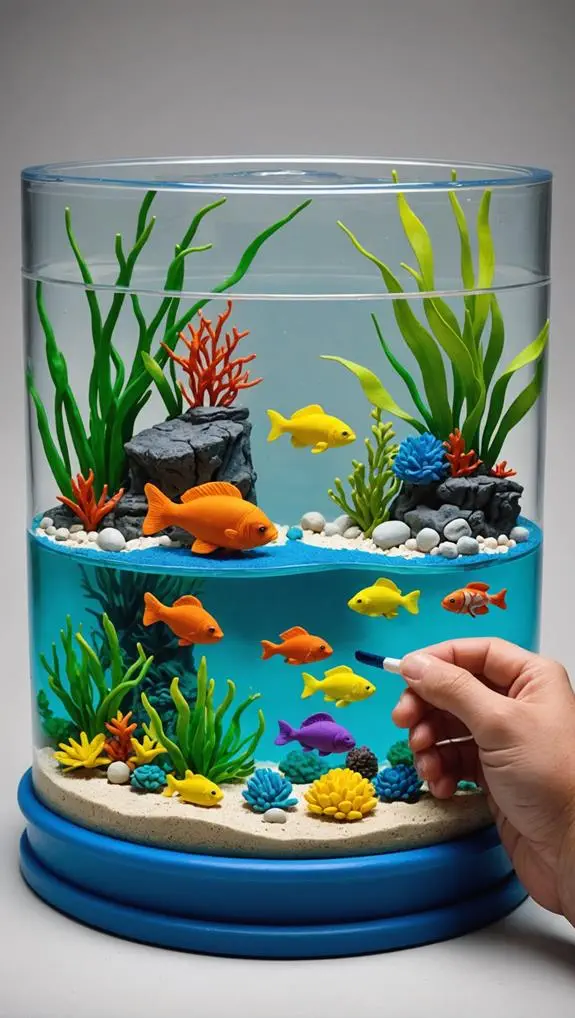
Upgrading your filtration system is only part of ensuring a healthy aquarium. You can't overlook the importance of testing water quality regularly. By keeping an eye on ammonia and nitrite levels, you're protecting your fishy friends from harmful spikes that could harm their health.
No one wants to be the fish owner who skipped a test and ended up with a mini underwater crisis!
It's a good idea to use test kits that measure not just ammonia, but also pH, nitrate, and phosphate levels. This way, you'll get a complete picture of your aquarium's health.
If you've got a new tank, remember to test weekly during those first months while the beneficial bacteria are getting established. For established tanks, routine testing every 2-4 weeks keeps things stable.
If you spot toxic levels, don't panic! Act quickly by performing a water change and checking your filtration system's effectiveness.
Keeping a regular testing schedule not only helps your aquatic pals thrive, but it also gives you peace of mind knowing you're doing your best for them.
After all, a happy fish tank makes for a happy home!
Seeking Expert Advice
Navigating the world of fish tank filtration can be overwhelming, but seeking expert advice can make all the difference. When you're facing common problems with your aquarium, reaching out to knowledgeable sources can help you create a healthy and thriving environment for your fish.
Here are some ways to tap into expert advice:
- Join established aquarium forums where enthusiasts share their experiences.
- Visit local fish stores and chat with staff who know their stuff.
- Connect with experienced aquarists who can offer specific insights about your filtration systems.
- Ask about troubleshooting techniques for issues like clogs or electrical faults.
- Engage in social media groups to learn from fellow aquarium lovers.
Frequently Asked Questions
Why Is My Fish Tank Filter Not Working Properly?
If your fish tank filter isn't working properly, check for common filter problems. Look for signs of malfunction, apply troubleshooting techniques, and remember filter maintenance tips like cleaning various filter media types to ensure optimal performance.
How to Know if a Filter Is Working in a Fish Tank?
Imagine watching your fish glide through crystal-clear water. To ensure your filter's working, listen for unusual noises, check the media, and follow maintenance tips. Regularly test water parameters for optimal filtration and a healthy tank.
Why Is My Aquarium Filter Running Slowly?
If your aquarium filter's running slowly, it might be due to clogging causes or pump inefficiencies. Regular filter maintenance tips, flow rate adjustments, and proper aquarium setup concerns can help restore optimal performance and keep your tank healthy.
Why Is My Fish Tank Dirty With a Filter?
It's ironic, isn't it? You've got a filter, yet your tank's dirty. Regular filter maintenance, proper fish waste management, and water quality tests can help. Consider different filter media types to enhance your tank's health.
Final Thoughts
In the grand underwater world of your fish tank, proper filtration is like the gentle current that keeps everything thriving. By tackling common issues, you're not just fixing problems; you're ensuring a happy, healthy home for your finned friends. So, keep your eyes peeled, test that water, and don't hesitate to seek help when needed. Remember, a well-maintained tank is a joyful one, and your fish will thank you with their vibrant colors and playful antics!

